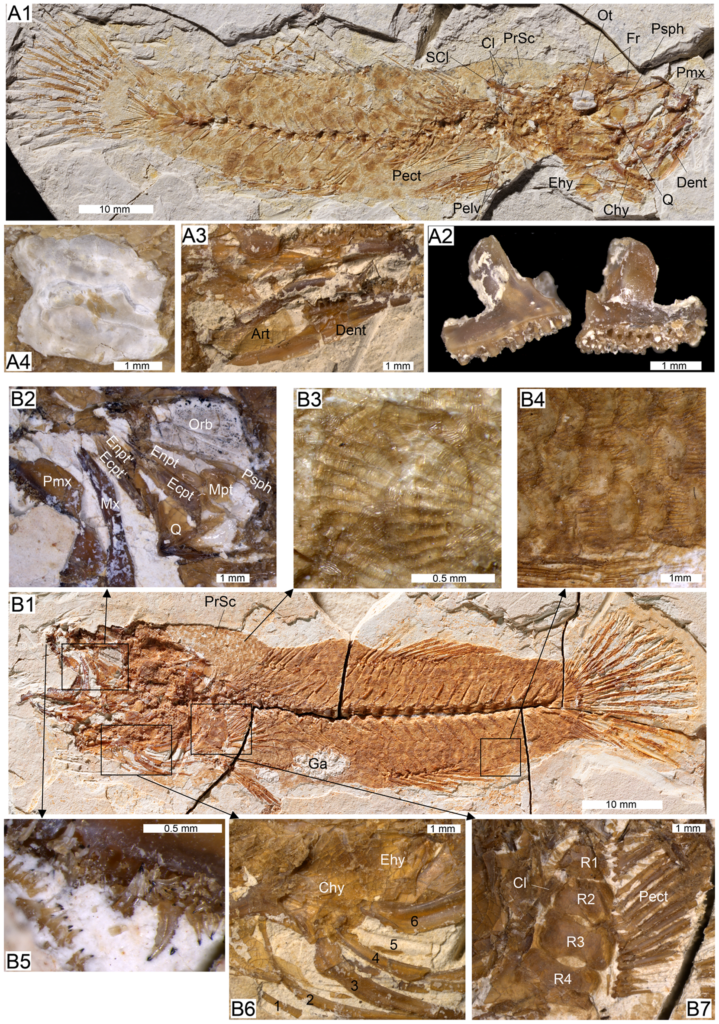@WFS,World Fossil Society,Riffin T Sajeev,Russel T Sajeev
An Extraordinary Gobioid Fish Fossil from Southern France
Abstract
Background
The classification of gobioid fishes is still under discussion. Several lineages, including the Eleotridae and Butidae, remain difficult to characterize because synapomorphies are rare (Eleotridae) or have not yet been determined (Butidae). Moreover, the fossil record of these groups is scarce.
Results
Exceptionally well-preserved fish fossils with otoliths in situ from uppermost Oligocene sediments (≈23–24 Mio. y. ago) in Southern France provide the most in-depth description of a fossil gobioid to date. The species was initially described as Cottus aries Agassiz, then transferred to †Lepidocottus Sauvage, and subsequently assigned to Gobius. Based on a comparative analysis of meristic, osteological and otolith data, this species most likely is a member of the family Butidae. This discovery is important because it represents the first record of a fossil butid fish based on articulated skeletons from Europe.
Significance
The Butidae and Eleotridae are currently distributed in W-Africa, Madagascar, Asia and Australia, but they do not appear in Europe and also not in the Mediterranean Sea. The new results indicate that several species of the Butidae thrived in Europe during the Oligocene and Early Miocene. Similar to the recent Butidae and Eleotridae, these fishes were adapted to a wide range of salinities and thrived in freshwater, brackish and marginal marine habitats. The fossil Butidae disappeared from Europe and the Mediterranean and Paratethys areas during the Early Miocene, due probably to their lack of competitiveness compared to other Gobioidei that radiated during this period of time. In addition, this study documents the great value of otoliths for gobioid systematics.

Osteology, scales and otolith of †Lepidocottus aries (Agassiz).
A: Specimen MC-P-2011-01-TF1. B: Specimen MC-P-2011-01-TF2. A1. General overview. Head displays right premaxilla (Pmx) and frontal (Fr) in lateral view, and several bones from the left head side in medial view (dentary (Dent), quadrate (Q), anterior ceratohyal (Chy), posterior ceratohyal (epihyal, Ehy)). The elongate parasphenoid (Psph) is also visible. The girdle exposes both pelvic fins (Pelv), the left supracleithrum (SCl), and imprints of the left pectoralis (Pect) and the uppermost part of the left cleithrum (Cl). The predorsal scales (PrSc) are well preserved. A2. Close-up of right premaxilla (isolated from skeleton) showing alveoles for the teeth and a complete processus articularis.
Citation: Gierl C, Reichenbacher B, Gaudant J, Erpenbeck D, Pharisat A (2013) An Extraordinary Gobioid Fish Fossil from Southern France. PLoS ONE 8(5): e64117. https://doi.org/10.1371/journal.pone.0064117
Editor: Laurent Viriot, Team ‘Evo-Devo of Vertebrate Dentition’, France
@WFS,World Fossil Society,Riffin T Sajeev,Russel T Sajeev



 April 9th, 2018
April 9th, 2018  Riffin
Riffin  Posted in
Posted in  Tags:
Tags: 